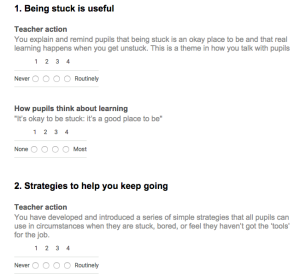About the Review Tools
Key aspects of learning are numbered 1-10. Under each aspect there are two related statements. Each pair consists of a statement relating to teaching approaches (the cause) and a linked statement relating to pupil behaviours (the effect).
A rating scale plots:
- a) how often do you use the approach
- b) how many pupils in the class behave or think like this.
About the statements
Teacher statements
These illustrate the sorts of things teachers have been doing in order to build the learning power learner.
For example: You discuss the idea of reflecting on learning. You build time into learning opportunities for focused reflective on the ‘how’ of learning
Pupil statements
There are 3 types of pupil statements:
1. Pupil self-perception or how pupils think about themselves as learners.
For example: I want to know more about things. “Asking questions means you want to know”. This means the child has realised what questions are for and that by asking you learn more.
2. Pupil self-talk for action. i.e. the sorts of things pupils will need to be saying to themselves to make sure they can take the appropriate action.
For example: “I can do well at this task by using……”. Here the child has a very practical way of thinking about what to use to achieve what is needed.
3. Pupil behaviour – the sort of things that pupils will be doing that give a positive foundation for learning power. Here pupils are monitoring their actions to make sure the activity is completed and successful.
For example: When pupils work in teams they keep an eye on how they are doing as they go along.
Organising a start-up review
The review is best undertaken in a spirit of:
- Curiosity
- Enquiry
- Ruminative discussion
- Evolving judgement
- And definitely NOT monitoring or checking up
The review tools can be used to:
- Share the good practice statements and learner statements with staff, in order to gain a feel for how you are doing.
- Enable different Key Stages and/or year groups to identify what they have been doing and how well it has worked.
- Begin to build up a picture of your pupils as learners and how this might differ across Key Stages or year groups.
- Find areas of strength you can build on, and establish priorities.
Here are some suggestions for organising the review. You can adapt, combine, extend, or do it completely differently.
- Key Stage team leaders discuss the tools with their teams. Each teacher then completes both tools for their class. In small schools this could be done as a group activity.
- When the team members have completed their questionnaires, they come together to discuss how they have interpreted the statements and reflect on any observations
- When each Key Stage or year group team has completed the review, the school requests delivery of the collated data and analysis sheet from TLO.
- Invite a group, with representation from year groups or key stages (whichever is appropriate) to analyse and interpret the whole school data.
Reflecting on the start-up review data
Having completed the review you will have some data to reflect on and play with. Here are some starting ideas.
Individual classes
Ask yourself:
- Does there seem to be one learning capacity (perseverance, collaboration, questioning, revising) that stands out as more secure than others?
- Within this capacity is there one aspect, or more, that stands out?
- For example, is pupil self-talk in perseverance lacking more than in other capacities?
- Look for the strongest capacities and the weakest capacities in terms of pupil behaviour and compare that with your score for the linked teaching actions.
- Does a weak aspect of a capacity correspond to you having done less work on it? If not what might be the cause?
- How does your teaching relate to:
- The strongest capacity.
- The weakest capacity.
- The strongest and weakest aspect of a capacity.
- Where have you been most successful – with most pupils showing the behaviour?
- Where have you been least successful?
Extend the thinking along these lines.
Year groups
- Are the results between classes different or similar?
- Is one class out of line?
- Have you all interpreted the scale in a similar way?
- What have you found that is interesting, puzzling or unexpected about these findings?
Key stages
- Is there a difference in the capacities showing strength or weakness across Key Stages?
- Are the strengths shown in KS1 carried forward to KS2?
- Where are the similarities and differences?
- What’s puzzling, interesting, expected?
Whole school
- What are the strongest and weakest capacities overall?
- Does this correlate with the amount of effort teachers have put into them?
- Where is more work needed? Where do you need to go next?


Comments are closed.